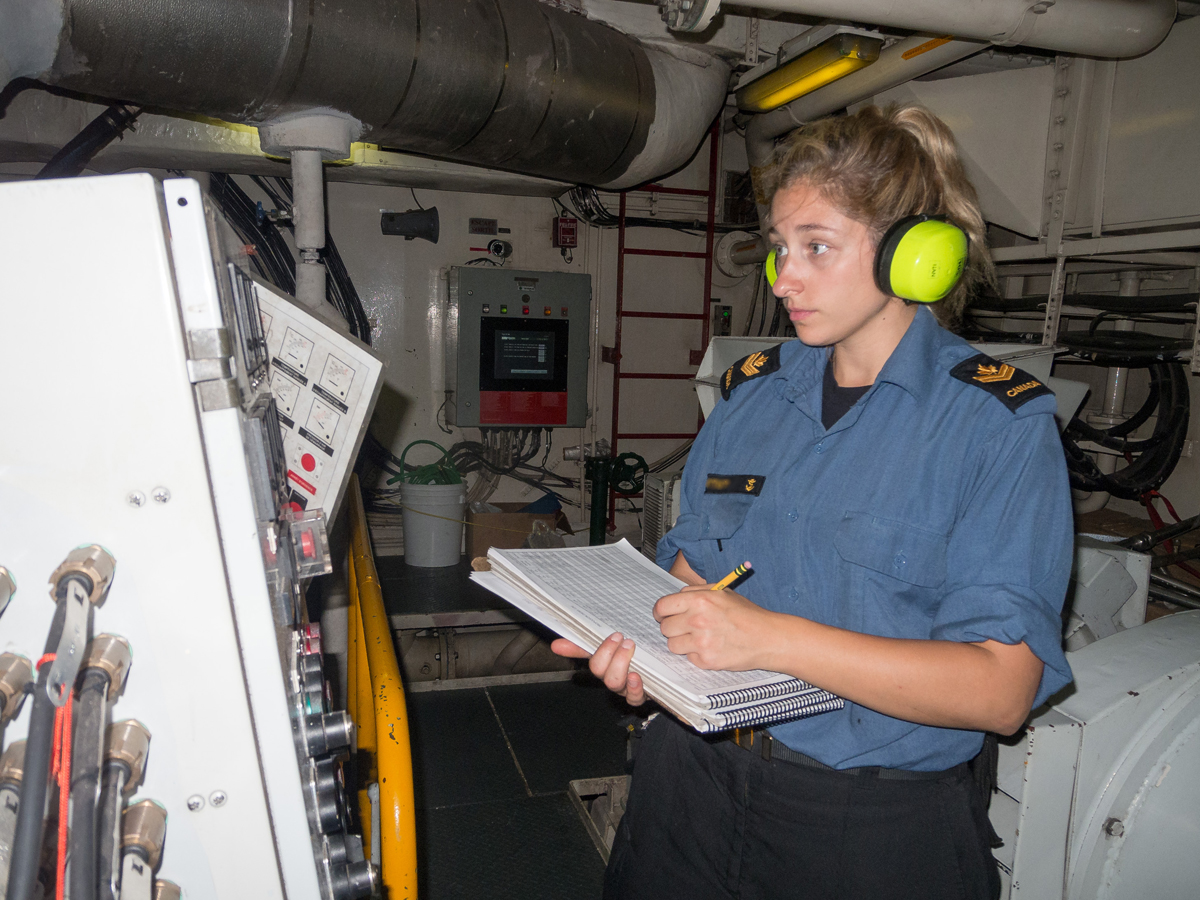
A Marine Technician records information from one of the ship’s diesel alternators as part of rounds.
Capt Jenn Jackson, Operation Caribbe PAO ~
The role of the Kingston-class Maritime Coastal Defence Vessels has certainly evolved in recent years. Originally used mainly for coastal surveillance, these 55-metre patrol vessels are now conducting extended operations such as Operation Caribbe.
With longer blocks of time spent at sea, the engineering section in a Kingston-Class is one of the busiest teams – both at sea and while alongside.
“The scope of the engineering team is quite diverse on this class of vessel,” says the Chief Engineer of HMCS Nanaimo, who cannot be named for operational security reasons. “During our deployment on Operation Caribbe, we are responsible for propulsion, power generation, water production, overseeing the maintenance programs for all departments, damage control monitoring, minor plumbing repairs and maintaining the radars and communications systems.”
Typically, nine non-commissioned members, from the Regular Force and Primary Reserve, including Marine Technicians with various qualification levels, and a Weapons Engineering Technician, make up the team. Two of the team members are critical for the ship to leave port.
“In order to sail, a C-ticket or CERT 4 qualified Chief Engineer and a legacy Senior Electrician must be embarked,” explains the Chief Engineer. “Other members of the team vary from ship to ship depending on the mission and availability of personnel, and it is common to have two to three Marine Technicians in the section working towards their next certification.”
Mentoring and on-the-job training are key components to Marine Technician training. Almost every day on the ship, the section spends up to two hours doing engineering drills both in practical and table-top formats.
“In addition to working towards initial qualification, Marine Technicians also have to maintain their certifications,” adds the Chief Engineer. “Doing engineering drills regularly allows senior members of the team to mentor junior members. Knowledge and lessons learned from real-world experiences are passed down ensuring information isn’t lost simply because a tech hasn’t had the opportunity to address an uncommon situation.”
When asked about the advantages of working on a Kingston-Class vessel, the Chief Engineer offers, “It’s an interesting opportunity. Because the section and crew of the ship is smaller, developmental opportunities to progress to supervisory positions and through the ranks are more available and you learn skills you wouldn’t on a larger platform. For example, as there is no logistics section on the ship, all departments are responsible for knowing how to order parts through the stores system or purchase during a foreign port visit to ensure we are operationally ready for the deployment.”
Storing and obtaining parts also presents challenges for the engineering section during extended sails – especially when parts have to be shipped to foreign ports on short notice.
“We have limited space to store equipment and parts on the ship, so we have to be smart about what we bring. Sometimes we must be innovative with repairs to keep the ship moving until we reach our next port and can get specific parts or have a contractor meet us to conduct full repairs.”
Despite the challenges, the engineering section of Nanaimo has already demonstrated its innovation during Operation Caribbe. The team installed and is maintaining a system of air conditioning units and fans to cope with the humidity and average temperatures of 30 degrees Celsius. They have also installed showerheads that can be easily be turned off to conserve water, all while maintaining existing systems to keep them going.
Whether the task is simple or complex, Nanaimo’s small engineering section is consistently maintaining the systems that keep us “Ready Aye Ready” and moving on Operation Caribbe.












